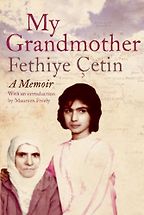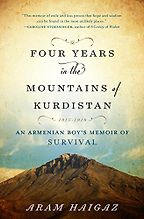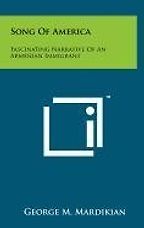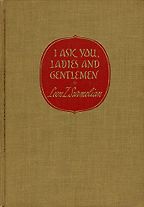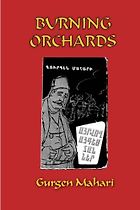Tom, you’ve chosen five books that are in some respects quite diverse. We have four male authors one female, we have two books translated from Armenian, one translated form Turkish and two originally written in English. They’re all personal memoirs and what holds them together is that they are memoirs rooted in the tragic events of 1915: in the mass-deportation and killing of Armenians in the middle of the First World War and the fate of individuals after that. These are very different individuals, two of them went to the States, one refers to a lady who stayed in Turkey, and one is by a famous writer who stayed in the Soviet Union. So the same starting point, but very different after that.
Shall we take the book that I found the most moving first? Fethiye Cetin’s My Grandmother. It’s remarkable that this book came out at all, isn’t it?
Yes, when it came out in 2004 this book really did cause a minor earthquake in Turkey, because it confronted Turks with the Armenians in their midst, both dead and alive. It’s an extraordinary story that broke the taboo in Turkey almost overnight, about the fact that so many people in Turkey had Armenian grandparents, or great-grandparents, who were the survivors as children of these horrific deportations in 1915, but who had been absorbed into Turkish society.
Fethiye Cetin tells the story of how her grandmother – a very beloved figure – in her mid-sixties suddenly revealed in secret that she wasn’t the Turkish lady Seher, who her granddaughter believed her to be, but an Armenian called Heranus. Her parents were not her real parents but her adoptive parents, who’d picked her up from of deportation column in 1915 as the Armenians were being destroyed – and as most of her family were being destroyed. This was a secret that she had carried with her most of her life.
“Every generation deals with this tragedy in a different way.”
It is a double-story, both of Seher/Heranus telling her life story and her childhood story, and also of the granddaughter coming to this extraordinary recognition of who her grandmother really is. Her whole identity is turned upside-down and she seeks out the lost Armenian relatives of her grandmother. She did track them down, but sadly only after her grandmother had died.
It’s a story on many levels and a story which challenged Turkey on many levels.
And it’s a story that unfolds in Turkey, whereas all the others involve people from Armenian communities who went elsewhere in a dramatic way. In Four Years in the Mountains of Kurdistan Aram Haigaz takes a very indirect route to the States, spending four years as a boy with a Kurdish family – converting to Islam and adopting their way of life – before eventually migrating. Did this book tell you much about the Armenian experience, or was it a general account of what it’s like to grow up as a boy in a Kurdish mountain community?
Well, obviously this is both an Armenian story and a Kurdish story. It’s newly published family memoir which is now in English. I found it fascinating.
I should start by saying that all these authors – or protagonists – were born at pretty much the same time, all around 1900, or a few years after; they were all children during 1915 but they all have very divergent experiences. Some of them manage to make it to the States, one makes it to Russian Armenia, the Soviet Union, one is completely absorbed into a Turkish family – who we’ve discussed – and then this extraordinary story, of an Armenian boy who lives as a Kurd for several years, in his teenage years, and is absorbed into this Kurdish household. It’s a vivid portrait of a mountain Kurdish community living in this pre-modern state, very beautifully observed. It’s told by a young boy who is very aware of his Armenian identity and is looking for chances to get away, which he eventually does at the end of the First World War in 1919. He escapes and re-finds his Armenian family. So it is the same story trajectory but with this extraordinary portrait of a Kurdish community in the middle.
Five Books interviews are expensive to produce. If you're enjoying this interview, please support us by donating a small amount.
At the end you’re getting the beginning of the next phase of violence and conflict in this region. The Kurdish rebellions are already beginning. First the Armenians are targeted by the Ottoman state and then it’s a matter of a Kurdish-Turkish fight, which then erupts in even greater force in the 1920s.
Aram Haigaz’s Armenian experience, his initial experience, is very dramatic because he grew up in this place Shabin Karahisar where people live half way up a mountain side and where they burned their own home settlement and holed up in a fort at the top of the mountain. They fought back quite aggressively. So his formative experiences were dramatic ones.
Yes. If we take a step back, we’re looking at this enormously dramatic and tragic story in 1915, which later became known as the Armenian Genocide: the story of how the entire Armenian population of the Ottoman Empire – with a very few exceptions – was targeted by the Young Turk government in Istanbul during the First World War for deportation. Of course this had multiple effects and – in a few cases – armed resistance, which is Aram Haigaz’s story and, to a certain extent, the story in the novel about Van by Gurgen Mahari: Burning Orchards.
Yes, this is a novel about Armenians fighting back. A novel that was controversial and, indeed, banned in the Soviet Union because it gave a very frank account of the political parties among the Armenians and the less-than-perfect characters who were involved in this narrative and so it had to be shortened or self-censored in order to be published in the Soviet Union.
This is an exceptional novel which deserves to be much more widely read, it’s beautifully written by a very talented writer with an extraordinary story. Gurgen Mahari grew up in Van in the Ottoman Empire then went to Russian Armenia – then in the Soviet Union – and spent many years as a political prisoner in the Gulag. He came back to Yerevan and then wrote this novel, which is basically an autobiographical novel about Van in 1915, which was the epicentre of a lot of Armenian-Turkish violence. It’s subversive because it’s not a martyrology, it’s not a story of Armenian victimhood. It’s told very much from the inside and it’s very satirical about the Armenian revolutionary parties and about the role they played in provoking and precipitating Turkish violence. This aspect of the novel was very controversial for the period in which it was published, the 60s, when Soviet Armenians were just rediscovering their political-national consciousness. This subversive take on the Armenian national idea was too much for the Yerevan of that period and Mahari was forced to withdraw the book from the publishers, some people even burned copies of the book. He re-submitted a self-censored version of this novel, his life’s work. But, by the sound of it, the experience broke him; he died a few years later.
What we now have is the complete version.
That’s right. The complete version was fortunately published much later.
When we have a great tragic event, a great atrocity – and I think the Armenian Genocide was the worst atrocity of the First World War – there is a tendency to sanctify it, to make the event into a pure morality tale. For me, that forms a barrier towards our human understanding of it. These five books – four memoirs, one autobiographical novel – bring us back to the human story, the fact that Turks could be good or bad, the fact that Armenians could be brave or not so brave, the choices people made, and the fact that this was history unfolding in real time.
These extraordinary events of war and destruction throw up incredible human stories. They tell us the story in a way that some of the dry history, and certainly the political propaganda about these events do not.
There are two books which follow more or less parallel tracks because they involve people moving from North-Eastern Turkey to America: Leon Surmelian’s I Ask you Ladies and Gentlemen, and George Mardikian’s Song of America. Mardikian’s book is on the whole a light and happy book. It’s mostly about his experience in the States, it’s a very Armenian experience but none the less a story of his success.
I chose this book as an example of that because Armenians are one of those people, unfortunately, whose national identity has been very identified with tragedy, with martyrdom. They’re not alone. We think of the Irish, the Jews, the Palestinians as nations who have some very awful tragedy at the centre of their historical experience. Armenians obviously fit into that category. But I chose this book because it’s an example of how it doesn’t have to be like that. It was published in the 50s and it’s a very affirming story of someone who has overcome the experience of immigration and tragedy and makes it in America. He’s a classic American immigrant in that he celebrates his birthday on July 24th, which was the day in 1922 when he landed at Ellis Island. He describes how he founded a famous restaurant in San Francisco, then went to Europe in the aftermath of the Second World War and was in charge of food operations for the US Army.
Get the weekly Five Books newsletter
It’s a great read. It’s not as though he was suppressing the Armenian tragedy, but he’s writing a story of emigration, of adaptation, of survival. It’s a rather bracing and a rather different take on Armenian history.
By comparison Leon Surmelian’s book is a darker one, in the sense that he’s a ten-year-old observing the terrible events in Trebizond and so it focusses more on the events in Turkey.
That’s right, although it’s also a story of immigration as well. This is a beautiful book which deserves to be republished, it’s out of print. The title is rather unfortunate. I like everything about this book except the title: I Ask you Ladies and Gentlemen, which is rather meaningless. If it was given a different title, it could be a bestseller as a memoir of this period. Again, it’s without this sense of victimhood, it’s a story of survival, although of great tragedy because his parents are lost in the 1915 genocide. As a small boy he’s also basically sold as a slave at one point on the deportation march and survives by his wits in various families and then escapes. It’s also about the town of Trebizond – a place that you know, Bruce, and have written about from the Pontic Greek perspective – so there are many Greeks in this book. He also describes living in various bits of the Black Sea at the end of the First World War until he emigrates to America, and describes the immigrant experience of being both welcome and alien. It’s a story lived in real time and described very beautifully. It deserves much wider readership.
Did you draw any conclusions about the Armenian diaspora experience: where there any fields Armenians thrived in? Was there any correlation between how the Armenians lived in the old world and how they lived in the new world?
The Armenians are a classic diaspora in that sense as they’re mercantile, adaptable. They have the stereotype of being able to survive anywhere, of practising various crafts and having business acumen. But the other thing to note here is that every generation is different. This is very much a theme of my book Great Catastrophe, which is about the aftermath of 1915. Every generation deals with this tragedy in a different way. In the 1920s it was through silence, talking about it at home, and survival. In the 1940s the issue hitches itself to Second World War politics. In the 1960s it’s different again, it’s about identity politics and the invention of the Civil Rights movement. It’s a reminder that nothing is static. There’s an assumption that the way an event is viewed in the collective consciousness of a community is the way it’s always been viewed, but that’s very far from the truth and certainly very far from the truth in the case of the Armenian Genocide.
“Rather than a pure morality tale, these five books bring us back to the human story of the Armenian Genocide.”
One talent that Armenians seem to have had in successive generation is literary. In William Saroyan the Armenians seem to have produced a significant American writer. I’ve been struck by the fact that whether they’re writing in Armenian (which is a language very few people speak), or in English, they express themselves very well and that’s one of the fields in which they’ve excelled.
Absolutely. And of course the Armenians are rightly proud of the fact that they’ve had their own alphabet since the fifth century, one of the main streets Yerevan — Mesrop Mashtots — is named after the monk who invented that alphabet. One of the first publishing industries in the world was Armenian: first through the church, and later secular. So there is a great literary tradition amongst the Armenians and at least three of the writers here are very literary writers as well.
It’s both a nation that is very introverted, in that it has held on to a language and script which is completely sui generisand very few other people speak, and yet it’s forced by experience to be highly extrovert and adaptable at the same time.
That’s a very good way of putting it. They’re a very brainy, literary people but they’re also very adaptable and associated with business. They are one of those people that are quite small in number in the world but make quite a significant contribution to world culture.
Indeed. And these are all stories of Armenian survival, both in a cultural sense and in a physical sense. Survival and adaptation. Of which I suppose the most extreme is survival by effectively being socialised into Turkish society.
I agree. I want to add that not one of these books uses the word genocide and that fits with my own agenda in my book. There is an important debate about the word genocide and the events of 1915, but behind that there’s an even bigger story about what happened to the Armenians, what happened to their culture, and what is owed to them in terms of memory and honouring their culture. A more direct route to understanding those bigger issues – certainly in Turkey – is to leave the word genocide to one side and to engage with the real, living human history.
Get the weekly Five Books newsletter
The way all these books describe the events of 1915 on the day-to-day level shows that what was going on was so unspeakably terrible that there’s no need to have intricate legal arguments or textual arguments about what does or doesn’t constitute genocide. They speak for themselves don’t they?
That’s right and I think if you read just these five books alone, you get a proper human and historical understanding of those events.
Interview by Bruce Clark
April 24, 2015. Updated: May 21, 2021
Five Books aims to keep its book recommendations and interviews up to date. If you are the interviewee and would like to update your choice of books (or even just what you say about them) please email us at [email protected]
